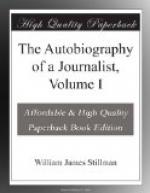But Miss A. still sat unmoved and helpless, so we waited. Presently she remarked that the influence wanted her to do something, she knew not what, only that she had to get up and go across the room, which she did with the feeble step of an old man. She crossed the room and took down from the wall a colored French lithograph, and, coming to me, laid it on the table before me, and by gesture called my attention to it. She then went through the pantomime of stretching a sheet of paper on a drawing-board, then that of sharpening a lead pencil, following it up by tracing the outlines of the subject in the lithograph. Then followed in similar pantomime the choosing of a water-color pencil, noting carefully the necessary fineness of the point, and then the washing-in of a drawing, broadly. Miss A. seemed much amused by all this, but as she knew nothing of drawing she understood nothing of it. Then with the pencil and her pocket handkerchief she began taking out the lights, “rubbing-out,” as the technical term is. This seemed to me so contrary to what I conceived to be the execution of Turner that I interrupted with the question, “Do you mean to say that Turner rubbed out his lights?” to which she gave the affirmative sign. I asked further if in a drawing which I then had in my mind, the well-known “Llanthony Abbey,” the central passage of sunlight and shadow through rain was done in that way, and she again gave the affirmative reply, emphatically. I was so firmly convinced to the contrary that I was now persuaded that there was a simulation of personality, such as was generally the case with the public mediums, and I said to my brother, who had not heard any of my questions, that this was another humbug, and then repeated what had passed, saying that Turner could not have worked in that way. After this I did not care to follow the conversation further.




